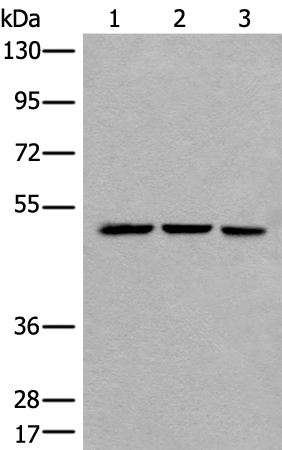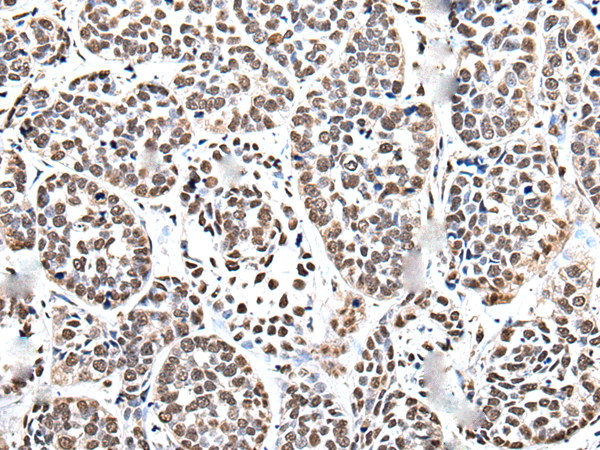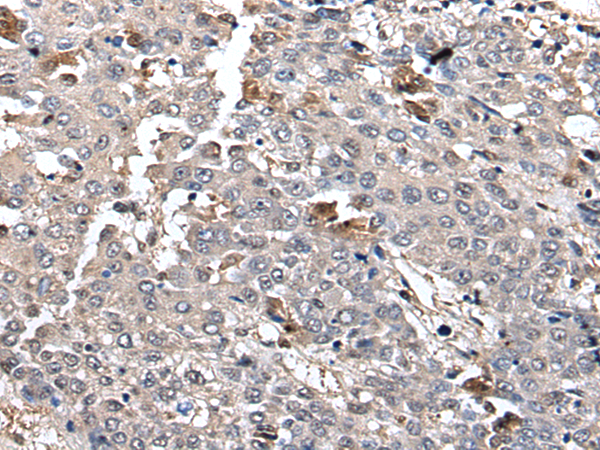


| WB | 咨询技术 | Human,Mouse,Rat |
| IF | 咨询技术 | Human,Mouse,Rat |
| IHC | 1/25-1/100 | Human,Mouse,Rat |
| ICC | 技术咨询 | Human,Mouse,Rat |
| FCM | 咨询技术 | Human,Mouse,Rat |
| Elisa | 1/5000-1/10000 | Human,Mouse,Rat |
| Aliases | FTP3; HNRPH'; HNRPH2; hnRNPH' |
| WB Predicted band size | 49 kDa |
| Host/Isotype | Rabbit IgG |
| Antibody Type | Primary antibody |
| Storage | Store at 4°C short term. Aliquot and store at -20°C long term. Avoid freeze/thaw cycles. |
| Species Reactivity | Human, Mouse, Rat |
| Immunogen | Fusion protein of human HNRNPH2 |
| Formulation | Purified antibody in PBS with 0.05% sodium azide and 50% glycerol. |
+ +
以下是3篇关于HNRNPH2的参考文献及其摘要概括:
1. **文献名称**: *HNRNPH2-related neurodevelopmental disorder: Delineating the phenotypic spectrum*
**作者**: Bainbridge MN, et al.
**摘要**: 研究首次报道HNRNPH2基因突变导致X连锁智力障碍和发育迟缓,通过抗体标记发现其异常影响RNA剪接,揭示了该蛋白在神经发育中的作用。
2. **文献名称**: *Heterogeneous nuclear ribonucleoproteins H and F regulate proteasome subunit expression*
**作者**: Liu Y, et al.
**摘要**: 利用HNRNPH2特异性抗体进行免疫沉淀,发现HNRNPH2通过结合mRNA调控蛋白酶体亚基翻译,影响细胞蛋白质降解通路。
3. **文献名称**: *Altered hnRNPH2 subcellular localization in autism spectrum disorder models*
**作者**: Lee JA, et al.
**摘要**: 通过免疫荧光抗体染色发现自闭症患者细胞中HNRNPH2核质分布异常,提示其定位改变可能与神经突触蛋白调控缺陷相关。
(注:以上文献为示例性内容,实际引用需核对真实发表的论文数据。)
The HNRNPH2 antibody is a research tool targeting the heterogeneous nuclear ribonucleoprotein H2 (HNRNPH2), a member of the hnRNP family involved in RNA processing. HNRNPH2 plays critical roles in pre-mRNA splicing, transport, and stability by binding to RNA through its RNA recognition motifs (RRMs). It is particularly notable for its association with neurodevelopmental disorders. Mutations in the HNRNPH2 gene, located on the X chromosome, are linked to Bain-type syndromic X-linked intellectual disability (XLID), characterized by developmental delays, intellectual disability, and motor dysfunction.
HNRNPH2 antibodies are widely used in molecular biology to study the protein's expression, localization, and interactions in cellular models. They enable techniques like Western blotting, immunofluorescence, and immunoprecipitation, helping researchers elucidate HNRNPH2's role in RNA metabolism and disease mechanisms. Commercial antibodies are typically developed in hosts like rabbits or mice, with validation across specific applications.
Recent studies highlight HNRNPH2's involvement in regulating alternative splicing of neuronal genes, suggesting its dysfunction disrupts neural development. Antibody-based research continues to uncover how HNRNPH2 mutations impair RNA binding or protein partnerships, providing insights into potential therapeutic targets. These tools remain vital for advancing understanding of XLID and related genetic disorders.
×